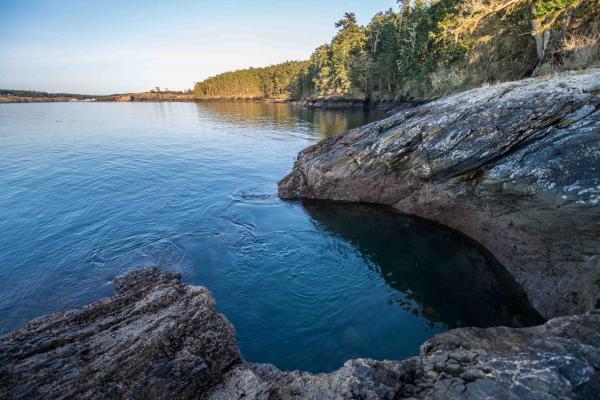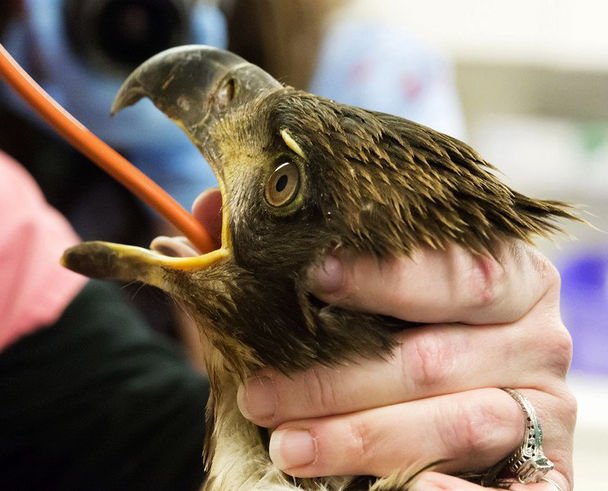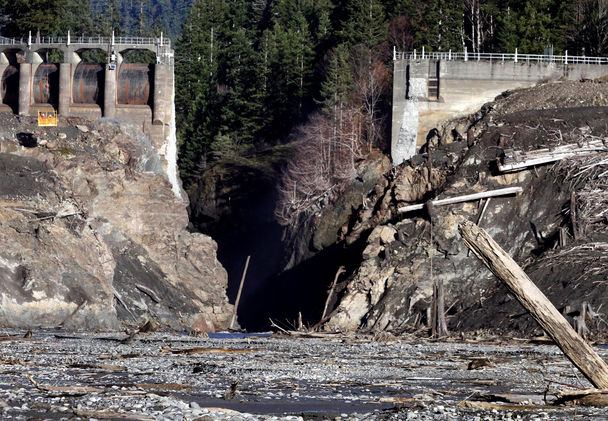
Source: Indian Country Today Media Network
On March 25, President Obama established the San Juan Islands National Monument by proclamation. The Islands, a stunningly beautiful archipelago off the coast of Washington state and home to abundant wildlife, will now enjoy the benefits of being a National Monument. The Coast Salish peoples, for which the islands are traditional and hereditary lands, are celebrating Obama’s move.

According to the National Park Service, San Juan Island has been a magnet for human habitation. Its location at the crossroads of three great waterways, plus sheltered harbors, open prairie and secluded woodlands, drew people wanting to stake a life, or find rest and relaxation amid an abundant food source.
The ancestors of today’s Northern Straits Coast Salish people began to appear in the wake of the continental ice sheet that started to recede 11,000 years ago. Archaeological evidence suggests that the island supported hunting and gathering between 6,000 and 8,000 years ago. The marine culture encountered by the first Europeans to the area developed about 2,500 years ago, and traces of its once thriving villages remain in the shell middens found along the shoreline of American and English camps and throughout the San Juan Islands.

By early historic times, the indigenous people of the San Juan Islands and nearby mainland areas were primarily members of six Central Coast Salish Tribes who spoke the Northern Straits language: Sooke, Saanich, Songhee, Lummi, Samish and Semiahmoo. Another Central Coast Salish tribe that entered the Northern Straits country spoke the closely related Klallam (or Clallam) language.
In addition to sharing these languages, the Central Coast Salish tribes shared a culture and way of life through which they used a wide range of marine, riverine, and terrestrial resources. They followed patterns of seasonal movement between islands and the mainland and from large winter villages to smaller resource collection camps occupied in the other seasons. Because of the exposure to severe winter winds and storms of the Strait of Juan de Fuca, those sites found within the Cattle Point-Mount Finlayson-South Beach were considered to be more likely seasonal subsistence and resource collection and processing camps, rather than permanent settlements.
The Lummi are one of the Coast Salish peoples whose ancestors lived in the San Juan Islands.

The San Juan Islands National Monument will encompass approximately 75 Bureau of Land Management sites totaling about 1,000 acres in San Juan, Whatcom and Skagit counties. Designation as a National Monument removes these lands from possible sale or development by the Bureau and engages the local community in developing and carrying out a management plan for these lands. Under permanent protection will be dozens of small islands in the San Juans, like Indian Island near the town of Eastsound, that provide breeding grounds for birds and safe refuges for everything from harbor seal pups to rare plants.These lands include ancient fishing sites and camas gardens that are important to Native American culture, and historically important lighthouses on Patos Island and Turn Point.
Also to be protected are popular recreation destinations in the islands like Iceberg Point and Watmough Bay on Lopez Island, Patos Island and Cattle Point on San Juan Island.

Here is the text of Obama’s proclamation, and visit the monument’s website: SanJuanIslandsNca.org.
Presidential Proclamation — San Juan Islands National Monument
ESTABLISHMENT OF THE SAN JUAN ISLANDS NATIONAL MONUMENT
– – – – – – –
BY THE PRESIDENT OF THE UNITED STATES OF AMERICA
A PROCLAMATION
Within Washington State’s Puget Sound lies an archipelago of over 450 islands, rocks, and pinnacles known as the San Juan Islands. These islands form an unmatched landscape of contrasts, where forests seem to spring from gray rock and distant, snow-capped peaks provide the backdrop for sandy beaches. Numerous wildlife species can be found here, thriving in the diverse habitats supported by the islands. The presence of archeological sites, historic lighthouses, and a few tight-knit communities testifies that humans have navigated this rugged landscape for thousands of years. These lands are a refuge of scientific and historic treasures and a classroom for generations of Americans.
The islands are part of the traditional territories of the Coast Salish people. Native people first used the area near the end of the last glacial period, about 12,000 years ago. However, permanent settlements were relatively uncommon until the last several hundred years. The Coast Salish people often lived in villages of wooden-plank houses and used numerous smaller sites for fishing and harvesting shellfish. In addition to collecting edible plants, and hunting various birds and mammals, native people used fire to maintain meadows of the nutritionally rich great camas. Archaeological remains of the villages, camps, and processing sites are located throughout these lands, including shell middens, reef net locations, and burial sites. Wood-working tools, such as antler wedges, along with bone barbs used for fishing hooks and projectile points, are also found on the islands. Scientists working in the San Juan Islands have uncovered a unique array of fossils and other evidence of long-vanished species. Ancient bison skeletons (10,000-12,000 years old) have been found in several areas, indicating that these islands were an historic mammal dispersal corridor. Butcher marks on some of these bones suggest that the earliest human inhabitants hunted these large animals.
The first Europeans explored the narrows of the San Juan Islands in the late 18th century, and many of their names for the islands are still in use. These early explorers led the way for 19th century European and American traders and trappers. By 1852, American settlers had established homesteads on the San Juan Islands, some of which remain today. In the late 19th century, the Federal Government built several structures to aid in maritime navigation. Two light stations and their associated buildings are located on lands administered by the
Bureau of Land Management (BLM): Patos Island Light Station (National Register of Historic Places, 1977) and Turn Point Light Station (Washington State Register of Historic Places, 1978).
The lands on Patos Island, Stuart Island, Lopez Island, and neighboring islands constitute some of the most scientifically interesting lands in the San Juan Islands. These lands contain a dramatic and unusual diversity of habitats, with forests, woodlands, grasslands, and wetlands intermixed with rocky balds, bluffs, inter-tidal areas, and sandy beaches. The stands of forests and open woodlands, some of which are several hundred years old, include a majestic assemblage of trees, such as Douglas fir, red cedar, western hemlock, Oregon maple, Garry oak, and Pacific madrone. The fire-dependent grasslands, which are also susceptible to invasive species, are home to chick lupine, historically significant great camas, brittle cactus, and the threatened golden paintbrush. Rocky balds and bluffs are home to over 200 species of moss that are extremely sensitive to disturbance and trampling. In an area with limited fresh water, two wetlands on Lopez Island and one on Patos Island are the most significant freshwater habitats in the San Juan Islands.
The diversity of habitats in the San Juan Islands is critical to supporting an equally varied collection of wildlife. Marine mammals, including orcas, seals, and porpoises, attract a regular stream of wildlife watchers. Native, terrestrial mammals include black-tail deer, river otter, mink, several bats, and the Shaw Island vole. Raptors, such as bald eagles and peregrine falcons, are commonly observed soaring above the islands. Varied seabirds and terrestrial birds can also be found here, including the threatened marbled murrelet and the recently reintroduced western bluebird. The island marble butterfly, once thought to be extinct, is currently limited to a small population in the San Juan Islands.
The protection of these lands in the San Juan Islands will maintain their historical and cultural significance and enhance their unique and varied natural and scientific resources, for the benefit of all Americans.
WHEREAS section 2 of the Act of June 8, 1906 (34 Stat. 225, 16 U.S.C. 431) (the “Antiquities Act”), authorizes the President, in his discretion, to declare by public proclamation historic landmarks, historic and prehistoric structures, and other objects of historic or scientific interest that are situated upon the lands owned or controlled by the Government of the United States to be national monuments, and to reserve as a part thereof parcels of land, the limits of which in all cases shall be confined to the smallest area compatible with the proper care and management of the objects to be protected;
WHEREAS it is in the public interest to preserve the objects of scientific and historic interest on the lands of the San Juan Islands;
NOW, THEREFORE, I, BARACK OBAMA, President of the United States of America, by the authority vested in me by section 2 of the Antiquities Act, hereby proclaim the objects identified above that are situated upon lands and interests in
lands owned or controlled by the Government of the United States to be the San Juan Islands National Monument (monument), and, for the purpose of protecting those objects, reserve as a part thereof all lands and interests in lands owned or controlled by the Government of the United States and administered by the Department of the Interior through the BLM, including all unappropriated or unreserved islands, rocks, exposed reefs, and pinnacles above mean high tide, within the boundaries described on the accompanying map, which is attached to and forms a part of this proclamation. These reserved Federal lands and interests in lands encompass approximately 970 acres, which is the smallest area compatible with the proper care and management of the objects to be protected.
All Federal lands and interests in lands within the boundaries of the monument administered by the Department of the Interior through the BLM are hereby appropriated and withdrawn from all forms of entry, location, selection, sale, leasing, or other disposition under the public land laws, including withdrawal from location, entry, and patent under the mining laws, and from disposition under all laws relating to mineral and geothermal leasing, other than by exchange that furthers the protective purposes of this proclamation.
The establishment of the monument is subject to valid existing rights. Lands and interests in lands within the monument boundaries not owned or controlled by the Government of the United States shall be reserved as a part of the monument upon acquisition of ownership or control by the Secretary of the Interior (Secretary) on behalf of the United States.
The Secretary shall manage the monument through the BLM as a unit of the National Landscape Conservation System, pursuant to applicable legal authorities, to implement the purposes of this proclamation, except that if the Secretary hereafter acquires on behalf of the United States ownership or control of any lands or interests in lands within the monument boundaries not owned or controlled by the United States, the Secretary shall determine whether such lands and interests in lands will be administered by the BLM as a unit of the National Landscape Conservation System or by another component of the Department of the Interior, consistent with applicable legal authorities.
For purposes of protecting and restoring the objects identified above, the Secretary, through the BLM, shall prepare and maintain a management plan for the monument and shall establish an advisory committee under the Federal Advisory Committee Act (5 U.S.C. App.) to provide information and advice regarding the development of such plan.
Except for emergency, Federal law enforcement, or authorized administrative purposes, motorized vehicle use in the monument shall be permitted only on designated roads, and non-motorized mechanized vehicle use in the monument shall be permitted only on designated roads and trails.
Nothing in this proclamation shall be deemed to enlarge or diminish the rights of any Indian tribe. The Secretary shall, in consultation with Indian tribes, ensure the protection of religious and cultural sites in the monument and provide access to the sites by members of Indian tribes for traditional cultural and customary uses, consistent with the American Indian Religious Freedom Act (42 U.S.C. 1996) and Executive Order 13007 of May 24, 1996 (Indian Sacred Sites).
Nothing in this proclamation shall be deemed to enlarge or diminish the jurisdiction or authority of the State of Washington or the United States over submerged or other lands within the territorial waters off the coast of Washington.
Nothing in this proclamation shall be deemed to enlarge or diminish the jurisdiction of the State of Washington with respect to fish and wildlife management.
Nothing in this proclamation shall be deemed to limit the authority of the Secretary of Homeland Security to engage in search and rescue operations, or to use Patos Island Light Station, Turn Point Light Station, or other aids to navigation for navigational or national security purposes.
Nothing in this proclamation shall be deemed to revoke any existing withdrawal, reservation, or appropriation; however, the monument shall be the dominant reservation.
Nothing in this proclamation shall be deemed to restrict safe and efficient aircraft operations, including activities and exercises of the Armed Forces and the United States Coast Guard, in the vicinity of the monument.
Warning is hereby given to all unauthorized persons not to appropriate, injure, destroy, or remove any feature of the monument and not to locate or settle upon any of the lands thereof.
IN WITNESS WHEREOF, I have hereunto set my hand this twenty-fifth day of March, in the year of our Lord two thousand thirteen, and of the Independence of the United States of America the two hundred and thirty-seventh.
BARACK OBAMA
Read more at http://indiancountrytodaymedianetwork.com/2013/03/26/we-have-monument-islanders-and-coast-salish-tribes-celebrate-president-obama-establishing








